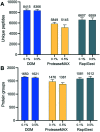Hanging drop sample preparation improves sensitivity of spatial proteomics
- PMID: 35838077
- PMCID: PMC9320080
- DOI: 10.1039/d2lc00384h
Hanging drop sample preparation improves sensitivity of spatial proteomics
Abstract
Spatial proteomics holds great promise for revealing tissue heterogeneity in both physiological and pathological conditions. However, one significant limitation of most spatial proteomics workflows is the requirement of large sample amounts that blurs cell-type-specific or microstructure-specific information. In this study, we developed an improved sample preparation approach for spatial proteomics and integrated it with our previously-established laser capture microdissection (LCM) and microfluidics sample processing platform. Specifically, we developed a hanging drop (HD) method to improve the sample recovery by positioning a nanowell chip upside-down during protein extraction and tryptic digestion steps. Compared with the commonly-used sitting-drop method, the HD method keeps the tissue pixel away from the container surface, and thus improves the accessibility of the extraction/digestion buffer to the tissue sample. The HD method can increase the MS signal by 7 fold, leading to a 66% increase in the number of identified proteins. An average of 721, 1489, and 2521 proteins can be quantitatively profiled from laser-dissected 10 μm-thick mouse liver tissue pixels with areas of 0.0025, 0.01, and 0.04 mm2, respectively. The improved system was further validated in the study of cell-type-specific proteomes of mouse uterine tissues.
Conflict of interest statement
There are no conflicts to declare.
Figures





Similar articles
-
An Automated and Fast Sample Preparation Workflow for Laser Microdissection Guided Ultrasensitive Proteomics.Mol Cell Proteomics. 2024 May;23(5):100750. doi: 10.1016/j.mcpro.2024.100750. Epub 2024 Mar 20. Mol Cell Proteomics. 2024. PMID: 38513891 Free PMC article.
-
Optimized nLC-MS workflow for laser capture microdissected breast cancer tissue.J Proteomics. 2012 Jun 6;75(10):2844-54. doi: 10.1016/j.jprot.2012.01.022. Epub 2012 Jan 24. J Proteomics. 2012. PMID: 22296676
-
Proteomic profiling of human islets collected from frozen pancreata using laser capture microdissection.J Proteomics. 2017 Jan 6;150:149-159. doi: 10.1016/j.jprot.2016.09.002. Epub 2016 Sep 13. J Proteomics. 2017. PMID: 27620696 Free PMC article.
-
Proteomics pipeline for biomarker discovery of laser capture microdissected breast cancer tissue.J Mammary Gland Biol Neoplasia. 2012 Jun;17(2):155-64. doi: 10.1007/s10911-012-9252-6. Epub 2012 May 30. J Mammary Gland Biol Neoplasia. 2012. PMID: 22644111 Free PMC article. Review.
-
[Laser capture microdissection and its practical applications].Cesk Patol. 2013 Oct;49(4):123-5. Cesk Patol. 2013. PMID: 24289481 Review. Czech.
Cited by
-
Exploring new frontiers in type 1 diabetes through advanced mass-spectrometry-based molecular measurements.Trends Mol Med. 2024 Dec;30(12):1137-1151. doi: 10.1016/j.molmed.2024.07.009. Epub 2024 Aug 15. Trends Mol Med. 2024. PMID: 39152082 Review.
-
Efficient and Sensitive Sample Preparation, Separations, and Data Acquisition for Label-Free Single-Cell Proteomics.Methods Mol Biol. 2024;2817:67-84. doi: 10.1007/978-1-0716-3934-4_7. Methods Mol Biol. 2024. PMID: 38907148
-
Spatial proteomics of single cells and organelles on tissue slides using filter-aided expansion proteomics.Nat Commun. 2024 Oct 30;15(1):9378. doi: 10.1038/s41467-024-53683-7. Nat Commun. 2024. PMID: 39477916 Free PMC article.
-
Proteome Mapping of the Human Pancreatic Islet Microenvironment Reveals Endocrine-Exocrine Signaling Sphere of Influence.Mol Cell Proteomics. 2023 Aug;22(8):100592. doi: 10.1016/j.mcpro.2023.100592. Epub 2023 Jun 15. Mol Cell Proteomics. 2023. PMID: 37328065 Free PMC article.
-
Intracellular Amyloid-β Detection from Human Brain Sections Using a Microfluidic Immunoassay in Tandem with MALDI-MS.Anal Chem. 2023 Apr 4;95(13):5522-5531. doi: 10.1021/acs.analchem.2c03825. Epub 2023 Mar 9. Anal Chem. 2023. PMID: 36894164 Free PMC article.
References
Publication types
MeSH terms
Substances
Grants and funding
LinkOut - more resources
Full Text Sources

